Services on Demand
Journal
Article
Indicators
-
 Cited by SciELO
Cited by SciELO
Related links
-
 Similars in
SciELO
Similars in
SciELO  uBio
uBio
Share
Phyton (Buenos Aires)
On-line version ISSN 1851-5657
Phyton (B. Aires) vol.81 no.1 Vicente López Jan./June 2012
ORIGINAL ARTICLES
An evaluation of the extent and threat of bark harvesting of medicinal plant species in the Venda Region, Limpopo Province, South Africa
Evaluación de la magnitud y peligro de la cosecha de corteza de especies vegetales medicinales en la región de Venda, Provincia de Limpopo, Sudáfrica
Tshisikhawe MP1, 2*, MW van Rooyen1, RB Bhat2
1 Department of Plant Science, University of Pretoria. 0002 Pretoria, South Africa.
2 Department of Botany, University of Venda. Private bag x5050, Thohoyandou, 0950, South Africa.
Address Correspondence to: M.P. Tshisikhawe, e-mail: tshisip@univen.ac.za
Recibido / Received 3.IX.2011.
Aceptado / Accepted 1/II/2012.
Abstract. The medicinal flora of the Venda region consists of a variety of species, which may potentially provide therapeutic agents to treat different diseases. Bark use for medicinal purposes has been reported for approximately 30% of the woody species (153 species) in the Venda region in southern Africa. However, only 58 plant species are commonly harvested for the medicinal properties in their bark and found in muthi shops in the region. These 58 species were scored for the possible threat of bark harvesting to the plant survival. Ethnobotanical studies indicate that the growing trade in indigenous medicinal plants in South Africa is posing a threat to the conservation and preservation of many plant species. Apart from pharmaceutical companies, trade in medicinal plants has become a way of making a living for some people. This study investigated the pattern of trade in medicinal plants by local markets in the Venda region, Limpopo Province, South Africa. Indications are that bark harvesting may threaten some of the plant species.
Keywords: Ethnobotanical trade; Medicinal plant species; Bark as a medicine source; Traditional healers.
Resumen. La flora medicinal de la región de Venda consta de una variedad de especies, que potencialmente pueden proporcionar agentes terapéuticos para tratar diferentes enfermedades. El uso de la corteza con propósitos medicinales se ha informado para aproximadamente 30% de las especies leñosas (153 especies) en el sur de África, en la región de Venda. Sin embargo, sólo 58 especies vegetales son cosechadas por las propiedades medicinales en su corteza, y vendidas en tiendas muthi en la región. Estas 58 especies se clasificaron por la posible amenaza de cosecha de su corteza, relacionado con la supervivencia de las plantas. Estudios etnobotánicos indican que el creciente comercio de plantas medicinales indígenas en Sudáfrica está siendo una amenaza para la conservación y preservación de muchas especies vegetales. Además de las compañías farmacéuticas, el comercio de plantas medicinales se ha convertido en una forma de vida para algunas personas. Este estudio investigó el patrón de comercio de las plantas medicinales en los mercados locales en la región de Venda, Provincia de Limpopo, Sudáfrica. Los resultados indican que la cosecha de corteza puede amenazar algunas de las especies vegetales.
Palabras clave: Comercio etnobotánico; Especies de plantas medicinales; La corteza como una fuente de medicinas; Curanderos tradicionales.
INTRODUCTION
Nature is full of undiscovered medicines and valuable chemicals that can potentially be used in healthcare systems and save countless lives (Raskin et al., 2002; Gurib-Fakim, 2006). Indigenous societies with their wealth of information about medicinal plants have long understood the importance of a healthy ecosystem for a continued supply of natural resources. As long as people harvest only what they need for treatment, a balanced ecosystem may be maintained, leading to sustainable harvesting of natural resources (Makoe, 1994). However, as a result of growing market demand, maintaining the ecosystem balance is currently a problem. Therefore, the unsustainable bark harvesting practices for medicinal purposes could lead to species disappearance. If so, the chemical secrets, that are probably only known by traditional healers, traders and indigenous societies, might be lost (Buenz, 2005).
Credo Muthwa, a well-known traditional healer, believes that muthi 1shop runners are the ones who heavily exploit animals and plants (Makoe, 1994). He indicated that shop owners hire people who do not understand the traditional ethics of collecting medicines.
Traditional medicine is regarded as an effective complement to the scientific forms of health care (alternative health care system). Inhabitants of some African countries still rely exclusively on plants as a source of medicines (Hostettmann et al., 2000; Lim, 2005; Gurib-Fakim, 2006; Nyika, 2009). The traditional healer talks to the patient in a holistic way, trying to find out the patient's state of mind and the state of his/ her relation with the family. In this way the traditional healer renders a social service. According to Professor Ralph Kirsch of the Department of Medicine at the University of Cape Town Medical School, traditional healers are caring people, and extraordinarily skilled in psychotherapy and counseling (see Kale, 1995). They are respected in their community, and regarded as counselors and leaders.
In South Africa most people make use of traditional medicines for their physical and psychological health needs (Rabe & Van Staden, 1997; Dold & Cocks, 2002; Keirungi & Fabricius, 2005). A strong adherence to traditional belief systems is found especially in areas characterized by high unemployment and insufficient government health services. The use and reliance on traditional medicines should be acknowledged and accepted; it cannot be wished away even as western medicine becomes available. Eighty per cent of the population consulting traditional healers have been found to be firm believers in muthi (Newton, 1997; Steenkamp, 2003; Fennell et al., 2004; Jager, 2005). One medical doctor, Dr N. Motlana, believed that 99 per cent of patients consulted traditional healers before they would turn up to western medicines (Levitz, 1992).
Proper regulations and harvesting methods must be imposed to collectors of medicinal plant material to ensure sustainability (Lewington, 1993; Springfield et al., 2005). It is important to know the plant species that are used and harvested for commercialization to promote sustainable utilization. Phytochemical screening is recommended to check the concentration levels of medicinal compounds in different plant parts. In some instances, traders might be selling only roots, whereas leaves of the same plant could also be used to treat the same disease effectively (Zschocke et al., 2007; Shai et al., 2009).
Most medicinal plants from the Venda region are sold outside Venda. For example, Brackenridgea zanguebarica Oliv. (Ochnaceae), which in South Africa is confined to the Venda region, has been found to be a very popular medicine (Netshiungani & Van Wyk, 1980). The bark of B. zanguebarica, for example, can be found in the stock of muthi sellers in the Lowveld, Johannesburg, Pretoria or Durban, beyond the Venda Region (Williams, 1996; Botha et al., 2007).
The objectives of this study were to:
. compile an inventory of indigenous woody plant species occurring in the Venda region with reported medicinal bark properties;
. provide a list of the plant species most commonly traded for medicinal bark properties in Venda;
. assess the persistence of the plant species commonly harvested for their bark in Venda;
. assess the proportion of different plant parts traded within the markets;
. determine the market value of indigenous plant species traded for their bark in the Venda region.
MATERIALS AND METHODS
Study area. The study on the availability and trade of bark from medicinal plant species was done in Venda region, South Africa, within the Vhembe District Municipality. Herbal shops around Thohoyandou and Sibasa towns were used to compile an inventory of the plant species that were sold, and to assess a record of sales. Thohoyandou is regarded as the center of trade in the Venda region mainly due to the presence of government buildings, the University of Venda and business centres.
Venda falls within the Soutpansberg region and is an area that is characterized by its great floristic diversity (Van Wyk & Smith, 2001). This is also reflected in the large variety of vegetation types found in the region. According to Mucina & Rutherford (2006), the vegetation of Venda consists of the following vegetation types: Musina Mopane Bushveld, Limpopo Ridge Bushveld, Makhado Sweet Bushveld, Soutpansberg Mountain Bushveld, VhaVenda Miombo, Maluleke Sandy Bushveld, Granite Lowveld and Tzaneen Sour Bushveld.
The climate of Venda is favourable for many South African tree species, with 535 woody plant species documented for the Soutpansberg (Hahn, undated). In the northern region there are 25 to 30 rainy days annually with rain falling mainly between December and February (50 to 75 mm per month). Less than 10 mm per month fall between May and September. The mean monthly temperature ranges from 28 °C in January to 15 °C in July. Humidity in the area is 40 ± 5% (Lorton communications).
Overall assessment of species with potential medicinal bark use in the Venda region. A species list of the woody plant species occurring in the Venda region was obtained from the PRECIS data base of the South African Biodiversity Institute (http://sibis.sanbi.org), and the tree list of the Soutpansberg (Hahn, undated). Reports of bark use for medicinal purposes were found for each species (Mabogo, 1990; Venter & Venter, 1996; Van Wyk et al., 1997; Palgrave, 2002; Tshisikhawe, 2002; Van Wyk, 2008; Van Wyk & Van Wyk, 2009). Plant names followed the electronic species list in Plants of South Africa version 2.5 (http://posa.sanbi.org).
Evaluation of trade of plant bark in the Venda region. Thohoyandou had five muthi shops in 1998 (Tshisikhawe, 2002). After a series of appointments, two traders in indigenous medicinal plants were selected for intensive studies and interviews: in Thohoyandou: Mr Netshia2 and Mrs Munyai3; at Sibasa, a main and a subsidiary muthi shops were investigated (Mr Tuwani4). Data were obtained only from the targeted main shop as it served as a store for the subsidiary one.
The indigenous plant use activities in the region were assessed through visits and interviews with traders, traditional healers, and medicinal material gatherers (middlemen). Specimens of plants involved in the study were collected and identified, and vouchers were deposited at the University of Venda herbarium. Collection of voucher specimens was done with help of a traditional healer who indicated their collecting areas and techniques.
Vulnerability of 58 plant species traded most for their medicinal bark properties in the Venda region. Table 1 lists the ecological and biological factors used to score the vulnerability of the 58 study species, harvested most commonly for their bark in the Venda region. These factors can also be used to establish conservation goals of the species, according to the method of Burgman et al. (2000).
Table 1. List of ecological factors used to score the vulnerability of the 58 species most commonly harvested for their bark in the Venda region.
Tabla 1. Lista de factores ecológicos utilizados para numerar la vulnerabilidad de las 58 especies cosechadas más frecuentemente por su corteza en la región de Venda.
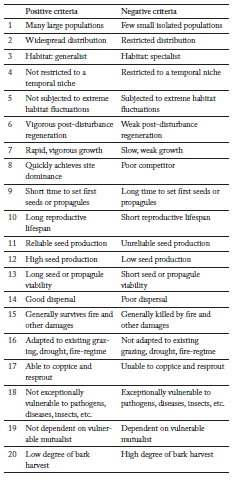
Each factor had two alternative states: (1) a positive state, related to species resilience, and (2) a negative state, referred to species vulnerability. Each factor was investigated at a species scale. If it was possible to obtain a reliable answer to the question, a +1 was given for resilience and a -1 was given for vulnerability. If the available species knowledge of the species was insufficient to obtain a reliable answer, a value of 0 was given to both resilience and vulnerability. The sum of all positive and negative scores was a measure of the vulnerability of the species. The maximum species score, for example, would be +20 if it scored positively on all ecological traits related to resilience. The lower the score, the more vulnerable the species was. The minimum score would be -20 if it scored negatively on all ecological attributes related to vulnerability.
RESULTS AND DISCUSSION
Overall assessment of species with potential medicinal bark use in the Venda regions. Four hundred and ninety eight woody plant species (excluding subspecies) were listed for the Venda region (PRECIS database; Hahn, undated). Of these species, 30.7% (n = 158) have been reported to have medicinal properties in their bark. However, only 11.7% (n = 58) of these species are actively traded for their bark in muthi shops around Venda. Overall, it is estimated that in South Africa more than 700 plant species are actively traded for their medicinal purposes (Dold & Cocks, 2002). Therefore, trade of bark for medicinal purposes in Venda contributes 8.2% of plant species traded for their medicinal purposes in South Africa. The Fabaceae is the most important family regarding its medicinal bark. This family constitutes 14.7% of all woody plant species (73 of the woody species) in Venda, but comprises 22.9% of those species with medicinal bark properties, and 27.6% of the medicinal plants that are traded for their bark. The Rubiaceae is the second most important woody family in Venda (9.4% of all woody plant species, n = 47). However, only 1.2% of these woody species have medicinal bark properties. The Fabaceae, therefore, is the most important family of plant species traded for their bark in Venda.
Evaluation of trade. Plant parts and species most commonly traded. The traders interviewed were predominantly traditional healers by profession. They practice their professions at home, and sometimes at their shops. Occasionally, they employ other people like relatives, children, and wives to run the shops. This is in line with the tradition that traditional healers pass their knowledge orally through generations. On the other hand, the chain of knowledge may be broken if none of the family members become interested in the practice.
In Venda, the trade of medicinal plant material is centralized in the urban business areas; it is uncommon to find people trading in the rural areas. This might be attributed to the fact that in rural areas people go directly to traditional healers for consultation and muthi dispensation. The introduction and popularity of muthi shops in urban areas is a result of urban people still preferring traditional medicines.
The research information that was collated from three shops (one at Sibasa and two in Thohoyandou) showed that the plant material marketed in Thohoyandou and Sibasa muthi shops ranged from roots, bark, leaves, and fruits, and in some cases, the whole plant. Figure 1 summarizes the percentage contribution of different plant parts that are most utilized in the preparation of medicines from the three shops. The most preferred plant parts were roots: 61% of the medicinal plant species found in the shops visited were in the form of roots; 22% in the form of whole plants; 15% in the form of stem bark; 1% in the form of fruits, and the other 1% in the form of leaves. Medicinal plant material was mostly traded in portions ranging from 4 to 850 g, although some were sold as powder.
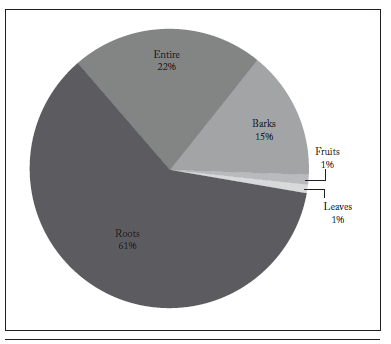
Fig. 1. Contribution of plant parts to medicinal trade in Venda (adapted from Tshisikhawe, 2002).
Fig. 1. Contribución de las partes vegetales al comercio medicinal en Venda (adaptado de Tshisikhawe, 2002).
Roots were the most important parts traded in the Venda region, followed by bark. In the Witwatersrand muthi markets, most of the plant species were traded for their roots and bark, although leaves, stems, whole plants and bulbs were also sold (Williams, 1996). In the Eastern Cape, trading of medicinal bark was very high and was second to roots (Dold & Cocks, 2002). However, in Maputo, Mozambique, more than 50% of plant species were traded for their roots and about 6% of medicinal material was traded in the form of bark (Krog et al., 2006). In Suriname, South America, barks are harvested in a non-destructive manner, and they only contribute to 6% of materials on market, while there are minor items (mostly aerial roots) that contribute only 5% (Van Andel & Havinga, 2008).
As indicated in Table 2 a total of fifty-eight medicinal plant species are harvested for their medicinal bark in Venda. In total, 26 plant families were listed, with the Fabaceae being the most prominent family, contributing 27.6% of these species. Bark, roots and bark, or the entire plant are used medicinally for 37 (63.8%), 17 (29.3%) or 4 (6.9%) of these species, respectively. Bark has multiple uses in 79.3% of the species, and plant parts have single use in 20.7% of them. Most of the species (45 species; 77.6%) are readily available, with 11 of them (19% of all listed species) being moderately available, and only two (3.4%) having a low availability.i.e. Brackenridgea zanguebarica and Warburgia salutaris (Canellaceae).
Table 2. Indigenous medicinal plant species from which bark is used as medicine in the Venda region.
Tabla 2. Especies de plantas medicinales nativas de las cuales se usa la corteza como medicina en la región de Venda.
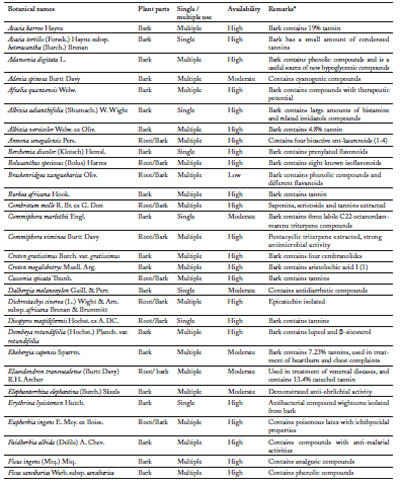
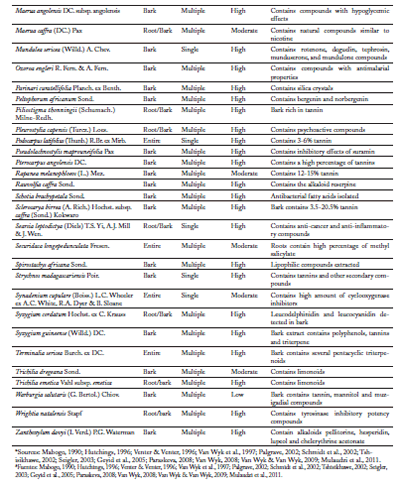
Of all the medicinal plants recorded, it is only Brackenridgea zanguebarica, which was collected at the same place by all traders interviewed. The fact that commonly traded plant species in Table 3, with the exception of Brackenridgea zanguebarica, are collected at different locations indicates a low level of collection pressure. The spread of the collection area is a good sign in terms of species conservation, preservation and sustainability. This is because it allows plants enough time to regenerate between collection periods. Collection by various collectors at the same locality, as is the case with B. zanguebarica, may result in pressure on the species. In addition, it indicates that the species is concentrated and restricted to one area.
Table 3. Comparison in terms of availability and collection locality of medicinal plant species most commonly traded in Thohoyandou (Tshisikhawe, 2002).
Tabla 3. Comparación de especies de plantas medicinales, en términos de disponibilidad y lugar de muestreo, frecuentemente comercializadas en Thohoyandou (Tshisikhawe, 2002)
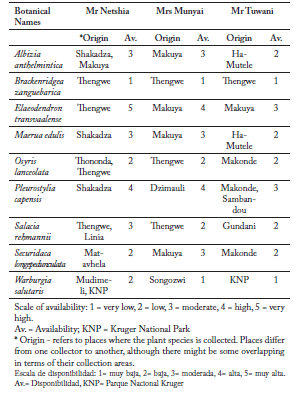
Table 3 lists nine of the most commonly traded plant species in Venda. Five of these species are traded for their bark and/or roots, i.e. Brackenridgea zanguebarica, Elaeodendron transvaalense (Celastraceae), Pleurostylia capensis (Celastraceae), Securidaca longepedunculata (Polygalaceae) and Warburgia salutaris. From Table 3 it is evident that species such as Elaeodendron transvaalense and Pleurostylia capensis are readily available to traders. The availability of these species is high, irrespective of the fact that they are among the most sought after and important medicinal plants.
Price / quantity relationship can be used to estimate the value of the plant material, since the relationship indicates its importance and popularity as a medicine. Powdered plant material was the most expensive, but not all traders offered it (Table 4). For example, powdered Elaeodendron transvaalense material at Mr Netshia's shop was 22 times more expensive than the non-powdered form at Mrs Munyai's shop. In addition to the large difference in price per mass at the different shops, it is important to note that the ranking was not always consistent among the traders. Availability also influences the price of a medicinal plant material. Some plant species are hard to find, because of scarcity or distance factors, which render them more expensive than those readily available. Some plant species, in particular Brackenridgea zanguebarica and Warburgia salutaris, were found to be out of stock, because of their popularity and scarcity, though in some cases it was because of their demand (Table 4).
Table 4. Comparison of species price and frequency of use of the most commonly traded species around Thohoyandou and Sibasa (Tshisikhawe, 2002).
Tabla 4. Comparación del precio y frecuencia de uso de las especies comercializadas más frecuentemente en los alrededores de Thohoyandou y Sibasa (Tshisikhawe, 2002).
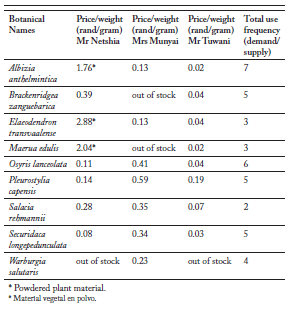
The scarcity of medicinal plants such as Warburgia salutaris and Brackenridgea zanguebarica (Table 3) is partly compensated for by the fact that they are not leading the list of plant species with high use frequency (Fig. 2), although they are still among the most traded species. Plants with the highest use frequencies were Albizia anthelmintica (Fabaceae) and Osyris lanceolata (Santalaceae). Brackenridgea zanguebarica was ranked third together with Pleurostylia capensis and Securidaca longepedunculata, while Warburgia salutaris was ranked fourth.
Generally, prepared plant materials are expensive when compared to unprepared ones (see prices of Elaeodendron transvaalense and Maerua edulis (Gilg & Gilg-Ben) De WolfSyn: Maerua decumbens (Bronzn) De Wolf; Capparaceae in Table 4). The high cost of prepared materials is mostly attributed to the time and energy spent during the collection and grinding processes.
An interesting aspect, which was evident in the muthi shops, was the interest in hemiparasites and epiphytes amongst the traditional healers, for example Viscum species (nzunzu). In one shop, 22 species of hemiparasites and epiphytes were recorded. The trade of hemiparasites and epiphytes is a new trend, and has also been noted by other researchers (Botha et al., 2001, 2004, 2007; Williams et al., 2010). During collection of medicinal materials, traditional healers showed great excitement when they found a hemiparasite or epiphyte rather than its host plant species. They believe that hemiparasites/ epiphytes are very strong medicinally, compared to the host plant species (Netshia pers comm.5).
Rituals observed during the collection include the spitting of saliva on the epiphytes before collecting. Performance of rituals is accompanied by invocations and praises to the ancestors. Interest in epiphytes may alleviate stress on affected plants that might be facing extinction, thereby giving them time to establish themselves again (Netshia pers. comm.5). However, trade on parasitic species might also be dangerous if rare parasitic species are overcollectede.g., Hydnora africana sensu Eyles (Syn: H. abyssinica A. Braun ex Schweinf; Hydnoraceae). It is clear that the trade of epiphytes and hemiparasites/parasites by the traditional healers will increase due to their considered healing powers.
Collectors of Medicinal Plants. Mr Netshia (pers. comm.) and Mr Tuwani6 (pers. comm.) collect medicinal plant material themselves, whereas Mrs Munyai7 (pers. comm.) depends on middlemen in most cases. Traditional healers usually train their middlemen in terms of collecting rituals for them to get good quality medicinal plant material. In fact, these middlemen end up helping people in their areas with minor problems.
According to Mrs Munyai, middlemen are only used in places of difficult access such as steep mountains, where the traditional healer may be a woman or an old person. However, middlemen have an effect on the price of material collected by them. On average, the price of unprepared medicinal material is high at Mrs Munyai's shop, as she gets most of her material through middlemen (Table 4). Middlemen come at a cost, and this cost is included in that of the medicine.
It should be noted that collection of medicinal materials implies a cost irrespective of middlemen involvement. The cost of collection is influenced by one or more of the following factors:
(i) Transport: The area of collection of medicinal materials varies according to their availability as well as the practitioner's knowledge of such species and habitat. The collecting distance increases with species depletion from any given area even for a practitioner with extensive knowledge on species distribution. The increase in collection distance brings about higher transport costs, which are absorbed by the clients.
(ii) Consultation fee: Traditional healers believe that when they are away on collection trips, a lot of clients remain unattended. Therefore, thousands of rands are lost in consultation fees because of their absence. The longer the time they spend looking for a particular medicine in the field, the more expensive the medicine will be.
(iii) Middlemen fee: They collect medicinal material for traditional healers at a given price. Prices of middlemen are fair since they are only needed under unfavourable conditions for the traditional healer; for example, when a female traditional healer needs a plant species which is only found at the top of a mountain. In this case, a young man is preferred as a middleman.
In some areas, however, there is no linear relationship between price/kg and medicinal material availability (Botha et al., 2007). The price/kg and the species availability may vary widely with consumer demand. Some medicinal plants are highly priced due to their costly labour intensive preparation techniques (Van Andel & Havinga, 2008).
The role of the middleman in the whole medicinal plant trading process should not be ignored. Their levels of knowl edge on rituals, and on the functioning of medicinal plants are essential. Usually middlemen start as assistants to traditional healers during plant collection. It is only after understanding the collection procedures that they qualify as collectors. Depending on their level of knowledge and understanding, middlemen may be as good as traditional healers in collecting medicinal plant materials.
Exportation from the Region. Some accounts of collectors from outside the Venda region were obtained from the Thengwe Territorial Council, where Brackenridgea zanguebarica was collected, through an interview with the headman (Nemafukani pers. comm8). This contributes to establish the extent of trade and destinations to which plants are exported.
Medicinal plant materials are extensively exported from the Venda region. Although there are no proper official records of medicinal plant material collection at the Thengwe Territorial Council on Brackenridgea zanguebarica, it was estimated that about a hundred traditional healers visited the area for collecting it annually (Nemafukani pers. comm8). The headman reported that some collectors came from as far as KwaZulu- Natal, Gauteng and Mpumalanga Provinces. According to the headman, control measures for Brackenridgea zanguebarica collection have now been set. Observations by Mr. Nemafukani are supported by Netshiungani & Van Wyk (1980), and Williams (1996). They noted that Brackenridgea zanguebarica was found in stocks of muthi sellers in Johannesburg and Pretoria.
Conservation and Sustainability Methods. Traditional healers still observe traditional rituals when collecting medicinal plant materials. The cultural beliefs of the Vhavenda people towards Brackenridgea zanguebarica are the main factor in its conservation and preservation (Netshiungani & Van Wyk, 1980).
Traditional healers always make sure that they leave behind a plant or population of plants that can regenerate and sustain themselves (Netshia pers comm.9). The success of their harvesting strategy is confirmed during their second visit to the collecting areas. An indication that traditional healers always have conservation in mind when collecting can be seen from the confidence they demonstrate when showing their collection sites. They are always sure that visiting their collecting areas can reveal the success of their conservation strategies and methods. This was confirmed when collecting voucher specimens with most traditional healers. For example, they harvest only a few lateral roots from any given plant, and then go to the next. The area where the roots have been collected from is immediately covered again to help survival of the plant.
It is only at the herb stage that healers uproot the whole plant, leaving some plants behind so that the population will be sustained. This whole plant is preferably used as medicine (i.e., where herbaceous species are used). This avoids collection of a large number of plants, and reduces the possibility of uprooting the whole plant. Collection of leafy parts only involves collection of a few small branches from the plant. Rituals like saliva spitting before branch collection are often performed as in the case of hemiparasites/epiphytes. They believe that if such an act is not performed, the medicine might not work effectively (Netshia pers comm.10).
Collection of bark involves removal of a few strips preferably from the stem. Traditional healers will never take the bark from all around the stem. This is because they believe that the plant should not die for the medicine to be effective in healing. Traditional healer Credo Muthwa (cited in Makoe, 1994) also confirmed the conservation of medicinal plants by traditional healers through collection rituals. Muthwa believes that if you take all the roots from the medicinal plant, at the same time you are also killing the patient you wanted to help. According to Muthwa, traditional healers from Botswana, Lebowa and Zimbabwe also confirm this traditional practice. In fact, to Credo Muthwa: "it is an insult to claim, or even suggest, that traditional healers play a role, active or sluggish, in the extinction of plants and animals". In Venda, the traditional practice of saving the plant was noticed during a voucher specimen collection field trip. According to Mabogo (1990), Venda traditional healers emphasize the need of avoiding killing the plants from which medicines are obtained.
Brackenridgea zanguebarica is regarded as threatened. As a result, conservation measures have been taken (i.e., making reserves around populations of this species. The conservation authorities and the headman make sure that there is no collection of medicinal plant materials from this reserve. Collection of medicinal plant materials is only done outside the reserve, and even this has been suspended since 1997 to allow recovery of Brackenridgea zanguebarica. Seedlings of this plant species, which establish themselves in great numbers under natural conditions, will have enough time to grow into mature plants (Nemafukani, pers. comm.). This will ensure a continuous and sustainable supply of medicinal plant material in the study area. People who collect medicinal material during the plant recovery period is arrested by the territorial council. Headmen receive a share in the cash generated from the areas where Brackenridgea zanguebarica is found; this is because ordinary people in such areas also play a conservationist role. This system of managing natural resources by involving traditional leaders and the community was found to be very successful. Despite collection being strictly monitored outside the reserve, and totally prohibited inside it, thieves are depleting the species from the surrounding area. This is why the endangered plant species is spared only in the reserve.
Vulnerabilitiy / resilience of the most 58 traded species for their medicinal bark properties in the Venda region. Vulnerability is a descriptor of long term in situ effects on populations or ecosystems. It is a function of exposure, effect and recovery potential to a disturbance (De Lange et al., 2010). A vulnerability score gives insight to those species that might be at risk, as it assesses each species on a number of sensitive criteria. Table 5 shows that the lower the vulnerability score, the more at risk the species would be to overutilization. Species such as Adansonia digitata (Bombacaceae) (8), Adenia spinosa (Passifloraceae) (4), Albizia adianthifolia (Fabaceae) (9), Albizia versicolor (Fabaceae) (5), Brackenridgea zanguebarica (6), Croton megalobotrys (Euphorbiaceae) (6), and Warburgia salutaris (8) may be at risk because of their vulnerability / resilience scores, which are below 10 (Table 5). The three vulnerable species that stand out are Albizia adianthifolia, Brackenridgea zanguebarica and Warburgia salutaris, which are among the nine most traded in Venda. On the other hand, the remaining most traded speciesElaeodendron transvaalense (15), Maerua edulis (19), and Securidaca longepedunculata (18) all had high scores. Osyris lanceolata, Pappea capensis (Sapindaceae) and Salacia rehmannii were not scored because they are not harvested for their bark.
Table 5. Vulnerability / resilience score for 58 plant species harvested for their bark in the Venda region.
Tabla 5. Número de vulnerabilidad para las 58 especies vegetales cosechadas por su corteza en la región de Venda.
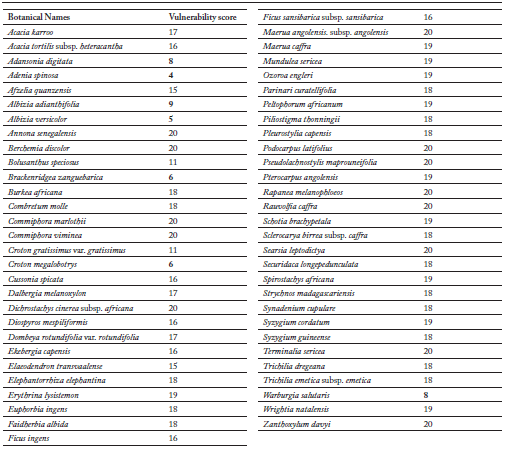
Vulnerability scores look at the totality of the criteria. A species may have a high degree of bark harvest, thereby scoring negatively, but would not be at risk due to positive scores on other criteria. Elaeodendron transvaalense (15), Peltophorum africanum (Fabaceae) (19), Pterocarpus angolensis (Fabaceae) (19), and Sclerocarya birrea subsp. caffra (Anacardiaceae) (18) are some of those species with a high degree of bark harvesting, but positive on other criteria. Therefore, bark harvesting alone cannot be used as a criterion to suggest that a species might be at risk. As a result, planning should be done to reduce or minimize holistic human-induced threats to biodiversity (Midgley & Thuiller, 2007; De Lange et al., 2010; Gauthier et al., 2010).
CONCLUSIONS
Only a proportion of the potential plant species with medicinal properties were found in the muthi shops investigated. However, bark harvesting constitutes a very important component of the trade of medicinal plant species. Five out of the nine most traded species were used for their bark. Among these five species, the two scarcest ones were counted, while one of them was only moderately available.
This study furthermore investigated the pattern of trade of medicinal plant species by local markets in the Venda region, Limpopo Province, South Africa. Venda in general, and Thohoyandou and Sibasa in particular, have few muthi trading shops. This is because the people trading medicinal plant material are at the same time traditional healers, who are able to collect medicinal plant material using their practicing certificates as their licenses.
Initiatives such as the formation of the Brackenridgea Reserve, aimed at the protection of Brackenridgea zanguebarica, should be fostered and expanded to include other threatened species. These reserves, around communities of threatened medicinal plants, must be supplemented by programs including threatened species in medicinal plant gardens or botanic gardens. The medicinal plant garden staff must also develop comprehensive programs of environmental education to the public, which will help in stressing the need for plant conservation.
Bark harvesting is very prominent in certain species (that are in demand) such as Brackenridgea zanguebarica and Elaeodendron transvaalense. However, recovery from bark harvesting differs between the two species. Brackenridgea zanguebarica shows good healing strategy. Trade of medicinal plants might be rife in Venda. However, most of the species whose bark is being traded are able to recover from the harvesting, and their populations are able to sustain themselves. Trading with bark can be detrimental when the species involved has a small population with a restricted distribution. If the population is large and widely distributed, the species has the potential of avoiding harvesting over the entire range. Although negatively reported, the species involved in trading for their bark in Venda are able to recover from harvesting due to their large populations that are widely distributed.
ACKNOWLEDGEMENTS
This research could never have been successful without the cooperation and willingness to share the indigenous knowledge by the traditional healers Mr Lucas Netshia, the late Mr Wilson Tuwani, and Mrs Nyamukamadi Munyai. We thank Mr DEN Mabogo for directing the initial phase of this research, and staff members from the Thohoyandou Botanical Gardens and the Brackenridgea Nature Reserve for their assistance in the species identification for their herbarium, and the voucher species collection in the field.
REFERENCES
1. Acocks, J.P.H. (1988). Veld types of South Africa. Botanical Research. Institute: Department of Agricultural Technical Services. Pretoria, South Africa. [ Links ]
2. Botha, J., E.T.F. Witkowski & C.M. Shackelton (2001). An inventory of medicinal plants traded on the western boundary of the Kruger National Park. Koedoe 44: 7-46. [ Links ]
3. Botha, J., E.T.F. Witkowski & C.M. Shackelton (2004). Market profiles and trade in medicinal plants in the Lowveld, South Africa. Environmental Conservation 31: 38-46. [ Links ]
4. Botha, J., E.T.F. Witkowski & C.M. Shackelton (2007). Factors influencing prices of medicinal plants traded in the Lowveld, South Africa. International Journal of Sustainable Development and World Ecology 14: 450-469. [ Links ]
5. Buenz, E.J. (2005). Country development does not presuppose the loss of forest resources for traditional medicine use. Journal of Ethnopharmacology 100: 118-123. [ Links ]
6. Burgman, M.A., H.P. Possingham, J.J. Lynch, D.A. Keith, M.A. McCarthy, S.D. Hopper, W.L. Drury, J.A. Pasioura, & R.J. Devries (2001). A method for setting the size of plant conservation target areas. Conservation Biology 15: 603-616. [ Links ]
7. De Lange, H.J., S. Sala, M. Vighi, & J.H. Faber (2010). Ecological vulnerability in risk assessment - A review and perspectives. Science of the Total Environment 408: 3871-3879. [ Links ]
8. Dold, A.P. & M.L. Cocks (2002). The trade in medicinal plants in the Eastern Cape Province, South Africa. South African Journal of Science 98: 589-597. [ Links ]
9. Fennell, C.W., K.L. Lindsey, L.J. McGaw, S.G. Sparg, G.I. Stafford, E.E. Elgorashi, O.M. Grace, & J. Van Staden (2004). Assessing African medicinal plants for efficacy and safety: pharmacological screening and toxicology. Journal of Ethnopharmacology 94: 205- 217. [ Links ]
10. Gauthier, P., M. Debusshe & M.D. Thompson (2010). Regional priority setting for rare species based on a method combining three criteria. Biological Conservation 143: 1501-1509. [ Links ]
11. Geyid, A., D. Abebe, A. Debella, Z. Makonnen, F. Aberra, F. Teka, T. Kebede, K. Urga, K.Yersaw, T. Biza, B.H. Mariam & M. Guta (2005). Screening of some medicinal plants of Ethiopia for their anti-microbial properties and chemical profiles. Journal of Ethnopharmacology 97: 421-427. [ Links ]
12. Gurib-Fakim, A. (2006). Medicinal Plants: Traditions of yesterday and drugs of tomorrow. Molecular Aspects of Medicines 27: 1-93. [ Links ]
13. Hahn, N. (Undated). Tree list of the Soutpansberg. Fantique Publishers, Pretoria. South Africa. [ Links ]
14. Hostettmann, K., A. Marston, K. Ndjaoko, & J. Wollfender (2000). The potential of African plants as a source of drugs. Current Organic Chemistry 4: 973-1010. [ Links ]
15. Hutching, A. (1996). Zulu Medicinal Plants: An Inventory. University of Natal Press, Pietermaritzburg, South Africa. [ Links ]
16. Jager, A.K. (2005). Is traditional medicine better off 25 years later? Journal of Ethnopharmacology 100: 3-4. [ Links ]
17. Kale, R. (1995). Traditional healers in South Africa: a parallel health care system. BMJ 310. [ Links ]
18. Keirungi, J. & C. Fabricius (2005). Selecting medicinal plants for cultivation at Nqabara on the Eastern Cape Wild Coast, South Africa. South African Journal of Science 101: 497-501. [ Links ]
19. Krog, M., M.P. Falcao & C.S. Olsen (2006). Medicinal plant markets and trade in Maputo, Mozambique. Forest and Landscape Working Papers no. 16-2006. Danish Centre for Forest, Landscape and Planning, KVL.Denmark. [ Links ]
20. Levitz, E. (1992). Traditional medicine - friend or foe? Publico 92. [ Links ]
21. Lewington, A. (1993). Medicinal plants and plants extracts: a review of their importation into Europe. TRAFFIC International. [ Links ]
22. Lim, M.K., P. Sadarangani, H.L. Chan & J.Y. Heng (2005). Complementary and alternative medicine use in multiracial Singapore. Complimentary Therapies in Medicine 13: 16-24. [ Links ]
23. Mabogo, D.E.N. (1990). The ethnobotany of the Vhavenda. Master of Science dissertation. University of Pretoria, Pretoria, South Africa. [ Links ]
24. Makoe, A. (1994). Muthi trade-affordable health care for our people. On track Summer 12-14. [ Links ]
25. Midgley, G.F. & W. Thuiller (2007). Potential vulnerability of Namaqualand plant diversity to anthropogenic climate change. Journal of Arid Environments 70: 615-628. [ Links ]
26. Mulaudzi, R.B., A.R. Ndhala, M.G. Kulkarni, J.F. Finnie & J. Van Staden (2011). Antimicrobial properties and phenolic contents of medicinal plants used by the Venda people for conditions related to venereal diseases. Journal of Ethnopharmacology 135: 330-337. [ Links ]
27. Netshiungani, E.N. & A.E. Van Wyk (1980). Mutavhatsindi - mysterious plant from Venda. Veld and Flora 66: 87-89. [ Links ]
28. Newton, D. (1997). Flora and fauna in the Medicine Cupboard. Endangered Wildlife 26. [ Links ]
29. Nyika, A. (2009). The ethics of improving African traditional medical practice: Scientific or African traditional research methods? Acta Tropica 112s: s32-s36. [ Links ]
30. Palgrave, K.C. (2002). Trees of Southern Africa. Struik Publishers, Cape Town. [ Links ]
31. Paraskeva, M.A. (2008). A phytochemical and pharmacological study of ten Commiphora species indigenous to South Africa. PhD thesis, University of Witwatersrand, Johannesburg. [ Links ]
32. Rabe, T. & J. Van Staden (1997). Antibacterial activity of South African plants used for medicinal purposes. Journal of Ethnopharmacology 56: 81-87. [ Links ]
33. Raskin, I., D.M. Ribnicky, S. Komarnitsky, N. Ilic, A. Poulev, N. Borisjuk, A. Brinker, D.A. Moreno, C. Ripoll, N. Yakoby, J.M. O'Neal, T. Cornwell, I. Pastor & B. Fridlender (2002). Plants and human health in the twenty-first century. Trends in Biotechnology 20: 522-531. [ Links ]
34. Seigler, D.S.(2003). Phytochemistry of Acacia-sensu lato. Biochemical Systematic and Ecology 31: 845-873. [ Links ]
35. Schmidt, E., M. Lotter & W. McClealand (2002). Trees and shrubs of Mpumalanga and Kruger National Park. 4th edition. Struik Publishers, Cape Town. Jacana Publichers, Johannesburg, South Africa. [ Links ]
36. Shai, L.J., L.J. McGaw & J.N. Eloff (2009). Extracts of the leaves and twigs of the threatened tree Curtisia dentata (Cornaceae) are more active against Candida albicans and other microorganisms than the stem bark. South African Journal of Botany 75: 363-366. [ Links ]
37. Springfield, E.P., P.K.F. Eagles & G. Scott (2005). Quality assessment of South African herbal medicines by means of HPLC fingerprinting. Journal of Ethnopharmacology 101: 75-83. [ Links ]
38. Steenkamp, V. (2003). Traditional herbal remedies used by South African women for gynecological complaints. Journal of Ethnopharmacology 86: 97-108. [ Links ]
39. Tshisikhawe, M.P. (2002). Trade of indigenous medicinal plants in the Northern Province, Venda region: their ethnobotanical importance and sustainable use. M.Sc. dissertation, University of Venda for Science and Technology, Thohoyandou, South Africa. [ Links ]
40. Van Andel, T. & R. Havinga (2008). Sustainability of commercial medicinal plant harvesting in Suriname. Forest Ecology and Management 256: 1540-1545. [ Links ]
41. Van Wyk, P. (2008). Field guide to the trees of the Kruger National Park. Struik Publishers, Cape Town, South Africa. [ Links ]
42. Van Wyk, A.E. & G.F. Smith (2001). Regions of floristic endemism in southern Africa: A review with emphasis on succulents. Umdaus Press, Pretoria. [ Links ]
43. Van Wyk, B.E., B. Van Oudtshoorn & N. Gericke (1997). Medicinal plants of South Africa. Briza Publications, Pretoria, South Africa. [ Links ]
44. Van Wyk, B. & P. Van Wyk (2009). Field guide to trees of southern Africa. Struik Publishers, Cape Town, South Africa. [ Links ]
45. Venter, F. & J.A. Venter (1996). Making the most of indigenous trees. Briza Publications, Pretoria, South Africa. [ Links ]
46. Williams, V.L. (1996). The Witwatersrand muthi trade. Veld and Flora 3: 12-14. [ Links ]
47. Williams, V.L., M.P. Falcao & E.M. Wojtasik (2010). Hydnora abyssinica: ethonobotanical evidence for its occurrence in southern Mozambique. South African Journal of Botany 77: 474-478. [ Links ]
48. Zschocke, S., T.Rabe, J.L. Taylor, A.K. Jager & J. Van Staden (2007). Plant part substitution - a way to conserve endangered medicinal plants. Journal of Ethnopharmacology 71: 281-292. [ Links ]














